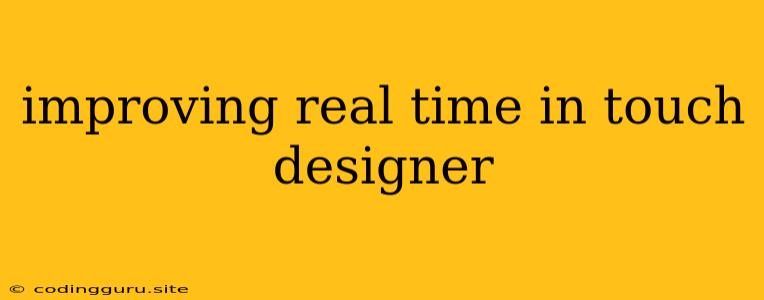Improving Real-Time Performance in TouchDesigner
TouchDesigner is a powerful and versatile visual programming environment, renowned for its ability to create stunning interactive experiences and real-time visual effects. However, achieving optimal real-time performance can sometimes be a challenge, especially when dealing with complex projects involving large datasets, computationally intensive operations, or high frame rates.
This article will explore various strategies and techniques for improving real-time performance in TouchDesigner, empowering you to create visually captivating and seamlessly interactive experiences without compromising on fluidity.
Understanding Performance Bottlenecks
Before diving into optimization techniques, it's crucial to identify the root causes of performance issues.
Common bottlenecks in TouchDesigner include:
- Excessive Network Communication: Excessive data transfer between different nodes or computers can significantly impact performance, especially over a network.
- Unnecessary Data Processing: Operations that unnecessarily process large datasets or perform complex calculations can strain system resources.
- Insufficient Hardware: Using outdated or insufficient hardware, like graphics cards or CPUs, can limit real-time performance.
- Inefficient Node Usage: Utilizing nodes that are not optimized for specific tasks or have inherent performance limitations can hinder overall efficiency.
Performance Optimization Strategies
1. Reduce Data Flow:
- Data Downsampling: When working with large datasets, consider downsampling to reduce the amount of data being processed. Techniques like averaging, decimation, or using a lower resolution can significantly improve performance.
- Data Caching: Store frequently used data in local memory (e.g., in a DAT) to avoid repetitive calculations and network transfers.
- Optimized Data Structures: Use data structures (like CHOPs) that are specifically designed for efficient data manipulation, instead of relying on generic DATs for data storage.
2. Optimize Node Usage:
- Node Selection: Choose nodes that are specifically designed for the tasks at hand. Utilize optimized nodes like the "GLSL TOP" for shader-based rendering instead of relying on more generic nodes.
- Node Order: Organize nodes to ensure that data flows efficiently. Place computationally intensive nodes later in the chain, as they might not need to process all the data if it's not necessary for the final output.
- Minimize Overlapping Operations: Avoid redundant calculations and data transfers by carefully planning your node network to minimize unnecessary processing.
3. Leverage Hardware Performance:
- GPU Acceleration: Utilize the power of your graphics card (GPU) for computationally demanding tasks like rendering or image processing. Explore the various GPU-accelerated nodes available in TouchDesigner.
- Multithreading: Leverage multicore processors by utilizing the built-in threading capabilities within TouchDesigner. This can significantly improve performance by distributing tasks across multiple processor cores.
4. Efficient Scripting Techniques:
- Optimization: Utilize techniques like loop unrolling and data pre-processing to optimize script execution and minimize processing time.
- Profiling: Identify performance bottlenecks within scripts using the "Profiling" feature in the TouchDesigner interface. This helps you pinpoint areas for optimization.
5. Consider Project Structure:
- Modular Design: Break down your project into smaller, reusable modules, enabling better organization and easier debugging.
- Component-Based Approach: Utilize a component-based architecture to create reusable UI elements and functional modules, improving overall code reusability and performance.
Example: Optimizing a Particle System
Let's consider a simple example of a particle system in TouchDesigner. To enhance real-time performance, we can apply the following strategies:
Initial Implementation:
- Generate particles using a "Random DAT."
- Move particles using a "Particle CHOP."
- Render particles using a "GLSL TOP."
Optimization:
- Reduce particle count: Instead of generating thousands of particles, consider reducing the particle count for a more efficient system.
- Downsampling: Use a "Downsample CHOP" to reduce the number of particles being processed by the "Particle CHOP."
- GPU Acceleration: Replace the "Particle CHOP" with the "GLSL TOP" to utilize GPU acceleration for particle movement and rendering.
- Optimized Data Structure: Store particle data in a "Particle CHOP" instead of a "DAT" for efficient manipulation.
By applying these optimizations, we can achieve a significant performance boost in our particle system, allowing us to generate more complex and interactive experiences in real-time.
Conclusion
Improving real-time performance in TouchDesigner requires a holistic approach that considers both the technical aspects of your project and the optimization strategies available within the software. By understanding performance bottlenecks, utilizing optimized nodes, leveraging hardware capabilities, and adopting efficient scripting techniques, you can create high-quality interactive experiences that run smoothly and efficiently.
